Panasonic ToughBook CF-19 Review
Panasonic ToughBook CF-19
Panasonic updates its lighweight fully rugged ToughBook with a dual core CPU.
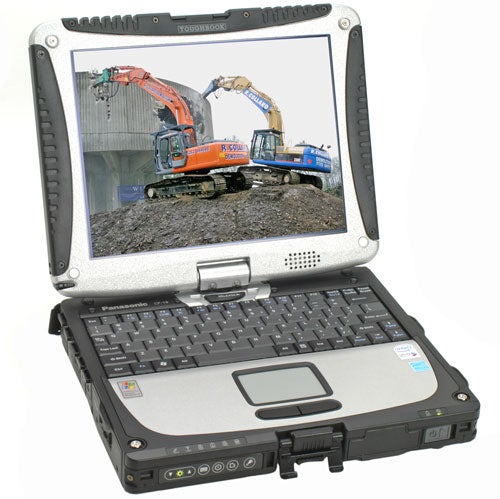
Verdict
Key Specifications
- Review Price: £2325.00
If you’re a regular reader of TrustedReviews you will have seen my previous ToughBook reviews. You will also be aware that I try to put these notebooks through as much punishment as possible while I have them in my possession. You see the Panasonic ToughBook is a very different type of notebook computer. It’s not about the latest CPU or the fastest graphics chip, oh no. The ToughBook line is all about survival!
I’m sure that Darwin wasn’t thinking about laptops when he wrote about natural selection, but I’d say that it’s a safe bet that if you threw a dozen notebooks on a desert island for a year, it would be the ToughBook that would survive the ordeal and claim the million Dollar prize. Whether or not Darwin actually coined the phrase “survival of the fittest” (it still seems to be open to debate), there’s little doubt that the ToughBook range of notebooks would survive the trials of life better than any other.

The CF-19 falls under Panasonic’s fully rugged moniker, meaning that it will stand up to almost anything. That includes being dropped from almost a metre, being showered with water, being thrown in the mud and being dragged through dust and sand. It’s therefore no surprise that ToughBooks are used by the US military, where the conditions are often inhospitable to say the least. In fact Panasonic was keen to mention that a ToughBook saved a soldier’s life during Desert Storm, which I mentioned in my CF-29 review.
The unusual thing about the CF-19 and the CF-18 before it, is that despite being as tough as an armadillo, it’s also pretty small and light. Weighing in at 2.25kg and measuring 271 x 216 x 49mm (WxDxH), the CF-19’s proportions don’t indicate that it could withstand serious abuse, but believe me, it can. The video embedded on this page shows the CF-19 being dropped from a metre high, being doused in water, having someone jump on it and having it doused in more water with the lid open. You can also see from the video that the CF-19 still worked after all that punishment and was happy to be doused in yet more water when powered on.
Because fully rugged ToughBooks are built to be used in extreme environments, pointer movement can be something of an issue. It’s hard to use a touchpad when it’s covered in mud or dust, so Panasonic has equipped the CF-19 with a touch screen instead. Now, when I reviewed the CF-29 I found it incredibly simple to navigate Windows with my index finger, but when I reviewed the CF-18 I realised that the 10.4in screen made this a little tricky. The same is true for the CF-19, which utilises the same 10.4in screen, but Panasonic gets around this problem by hiding a stylus just below the screen. Continuing with the rough and ready theme, there’s also a supplied cord that attaches the stylus to the CF-19, to make sure that you don’t lose it while you’re kyaking down the Yukon.
Adding to the CF-19’s industrial feel is the solid metal catch that secures the lid – there are no small plastic hooks here, there is no way that this notebook will open up unless you want it to. Lifting the lid reveals that 10.4in touch screen which is surprisingly bright – touch screens tend to be a bit dull due to the membrane that is needed for the touch functionality, but the screen on the CF-19 is so bright that I actually had to turn the brightness down a couple of notches when writing this review. Again, this is testament to the environments that a machine like this will be used in, where it’s vitally important to be able to see the screen clearly no matter what the lighting conditions. The screen is protected by a magnesium alloy housing, although the screen itself can survive a fair amount of abuse, in fact when we torture tested the CF-18 we dropped it with the screen facing out and it survived without a scratch.
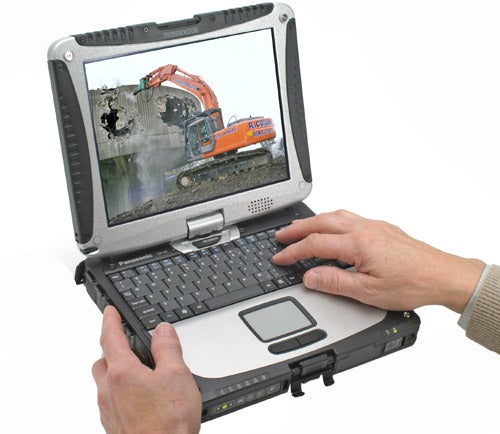
Below the screen is a Release catch that allows you to twist the display through 180 degrees and then slap it shut against the body creating a tablet form factor. With the touch screen this makes it possible for field engineers, warehouse admin staff or just about anyone to use the CF-19 as a data logging device that’s tough as nails. In most corporate roll outs ToughBooks will be running bespoke applications that will take advantage of their unique attributes. Panasonic even offers a custom build option where corporate clients can submit their own image of applications to be loaded onto each machine at point of build. If you need the functionality of a full Tablet PC device, the CF-19 can be specified with Windows Tablet PC Edition and a digitiser screen instead of a touch screen.
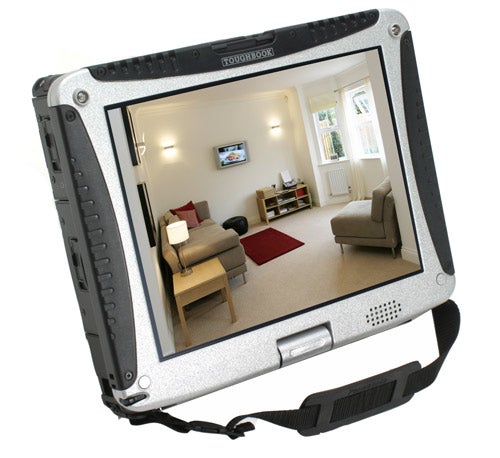
It’s a fair bet that the CF-19 will be used with bespoke applications, since the keyboard sports very small keys. I can function reasonably well on this keyboard, as can be seen by the fact that I’m writing this review on it, but anyone with larger hands would find it very difficult to type for extended periods. As with the CF-18, my biggest issue with the keyboard is the fact that Panasonic has changed the layout of the cursor keys, making keyboard cursor manipulation unintuitive to say the least. Below the keyboard is a touch pad with two selector buttons below it. This worked very well, but I found myself using the touch screen most of the time instead.
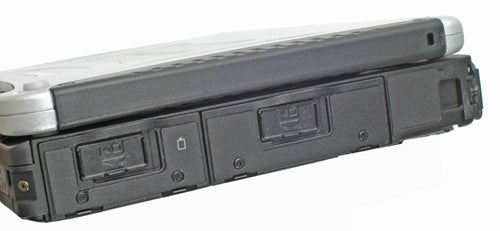
Being a fully rugged notebook, every port and connector is covered by a waterproof/dustproof flap. On the right side of the chassis you’ll find two hinged doors which are secured by a sliding catch for extra piece of mind. Behind these you’ll find the removable battery and the removable hard disk enclosure. The latter is one of the key elements to the ToughBook range – the shock resistant hard disk enclosures ensure that your data stays safe even if you bash or drop your notebook from a significant height.
At the rear you’ll find headphone and mic sockets, a USB 2.0 port, a D-SUB connector and a serial port. All of these are hidden behind waterproof flaps. The left side is most feature rich with sealed flaps hiding the power socket, another USB 2.0 port, a four-pin FireWire port, a modem socket and an Ethernet port. There’s also a large hinged door, complete with locking catch behind which hides a Type II PC Card slot, an Express Card slot, an SD card slot and a hardware switch for the integrated Wi-Fi adapter.
At the front is a sliding power switch and an array of buttons – here you’ll find controls to adjust the screen brightness in case you’re in tablet mode, a left mouse button, a screen rotate button, a button to logout of Windows and a button to bring up a virtual keyboard. The latter didn’t appear to work, but I’m assuming that it’s a feature for the Tablet PC Edition of the CF-19.
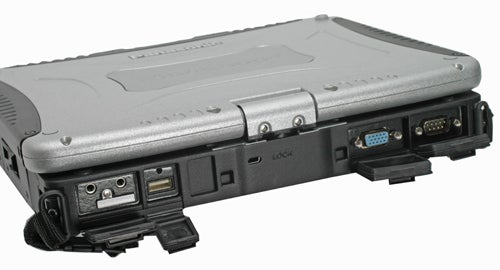
Unlike the CF-18 before it, the CF-19 benefits from a dual core CPU albeit the older Core Duo version. This isn’t really an issue since the ToughBooks are more about reliability and battery life than they are about performance. That said, the Core Duo chip is still a damn good CPU, even in its Ultra Low Voltage guise as seen here – the CF-19 is equipped with a U2400 Intel Core Duo running at 1.06GHz, which is fairly modest by power notebook standards, but I didn’t have any problems running all the applications that I needed. More concerning is the modest 512MB of system memory, especially since the Intel integrated graphics chipset eats up a chunk of that. My advice would be to specify at least 1GB of memory at point of purchase, or even 2GB if you can stretch to that.
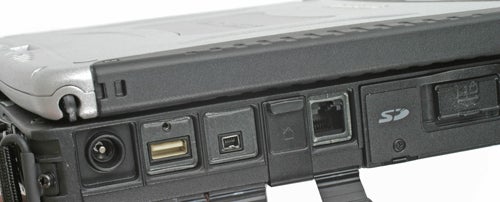
The well protected hard disk provides a modest 80GB, but the target buyer isn’t going to be dumping a load of music and video files on this machine, so that’s probably quite adequate. Having recently seen a 32GB solid state disk out at CES I’m wondering how long it will be before Panasonic employs this kind of technology into its ToughBooks, making them even more robust. Conspicuous by its absence is an integrated optical drive, but in a corporate roll out, machines like these are likely to be configured over a network and end users installing anything themselves will probably be frowned upon, if not altogether forbidden. Of course it’s easy enough to plug a USB optical drive into the CF-19, which is exactly what I had to do to get the benchmarks loaded.
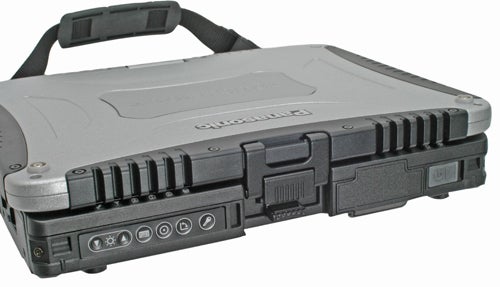
The CF-19 is well catered for when it comes to wireless communication. There’s integrated Bluetooth for connection to a mobile phone or Bluetooth enabled camera, while the Intel PRO/Wireless 3945ABG Wi-Fi adapter provides 802.11a, b and g support. It’s also worth noting that Panasonic was offering wireless WAN modules in its ToughBooks long before the rest of the notebook world had even thought about it. I can still remember when a couple of BT engineers turned up to my home to install my ADSL back in 2000 – they were both equipped with ToughBooks complete with GSM modules built-in for wireless data communication from anywhere. Of course now that 3G and HSDPA integrated modules are all the rage, Panasonic has added an HSDPA module to its option list for the CF-19.
One area where the CF-19 really excels is battery life. Running Mobile Mark 2005 resulted in a battery life of over seven hours, which should mean that an engineer could take the CF-19 out with him/her in the morning and not have to worry about finding a power socket all day. It’s also worth noting that the battery life on the CF-19 is over an hour better than the outgoing CF-18.
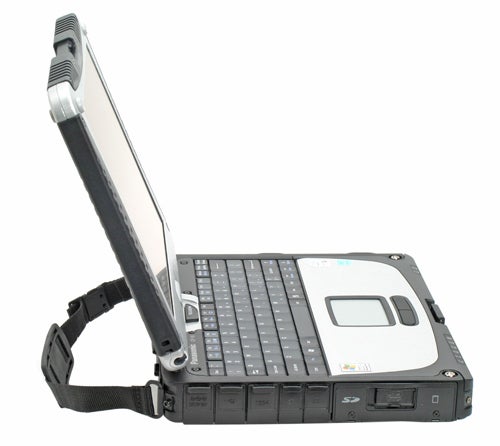
Likewise the PCMark score jumped significantly from what I saw on the CF-18 at 2173 over 1863. Obviously the newer dual core CPU will account for much of this, but even the hard disk and graphics portions of the test showed marked improvement. I didn’t manage to get SYSmark to run on the CF-18, but the CF-19 certainly didn’t let itself down with a score of 190, although that could easily be improved upon with more system memory.
Of course it’s worth remembering that even though the CF-19 has improved on the benchmark set by the CF-18, the notebook game has moved on considerably since then. The CF-19 compares favourably to its outgoing sibling, but it’s a way behind the scores turned in by average Core 2 Duo notebooks these days. But as I’ve always said, a ToughBook isn’t about system performance, it’s about a package that you can rely on, no matter how harsh the environment you use it in.
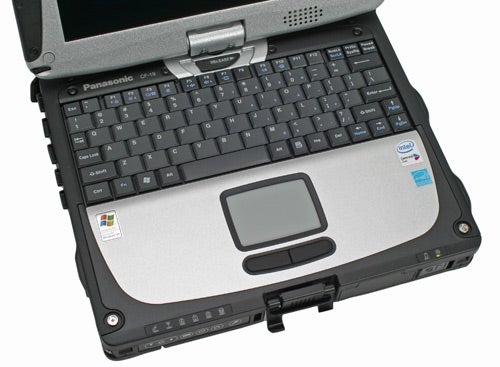
Price wise, the CF-19 actually comes in slightly cheaper than the CF-18, although at £2,325 including VAT it’s still far from cheap. If you want the integrated HSDPA module, the whole bundle will set you back £2,843 including VAT. Those numbers may look scary, but what you’ve got to remember is that you only buy a fully rugged ToughBook if no other notebook will take the abuse you’re likely to throw at it, and that’s what you’re buying into, durability.
Panasonic invests a lot into R&D and testing into the ToughBook range, and much of the technology used inside these machines was developed by Panasonic’s own engineers. I’ve been curious for a while as to just how tortuous the testing regime is at Panasonic’s ToughBook facility in Japan. So, to satisfy my curiosity I’ll be flying out to Japan at the end of the month to meet Panasonic’s ToughBook designers and engineers, and see just what they put each model through before signing off on it. Of course I’ll be writing a full report when I get back.
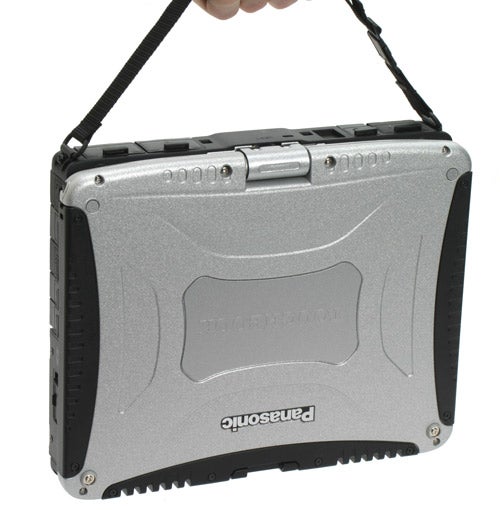
”’Verdict”’
If you want a reasonably small and light notebook that will stand up to almost anything you’re likely to throw at it, the ToughBook CF-19 is just what you’re looking for. The keyboard doesn’t lend itself to writing long reports or essays, but this machine is more likely to be used with bespoke applications for data entry out in the field. With the option of an HSDPA module, engineers and field workers will now be able to communicate and send data back to the office even faster.
If however you’re looking for something that is tough as nails and can be used to write long documents just like any other notebook, you’re probably better off waiting for the forthcoming ToughBook CF-30, which I’ll be reviewing soon. Ultimately, the CF-19 makes a few ergonomic sacrifices for the sake of weight and size, while throwing the tablet style operation into the mix, and if that’s what you need, look no further.
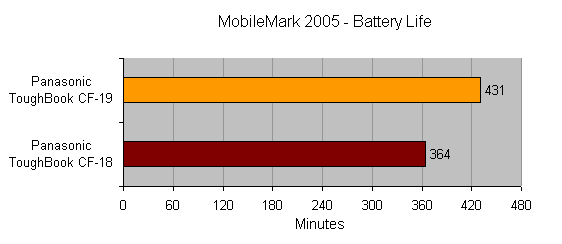
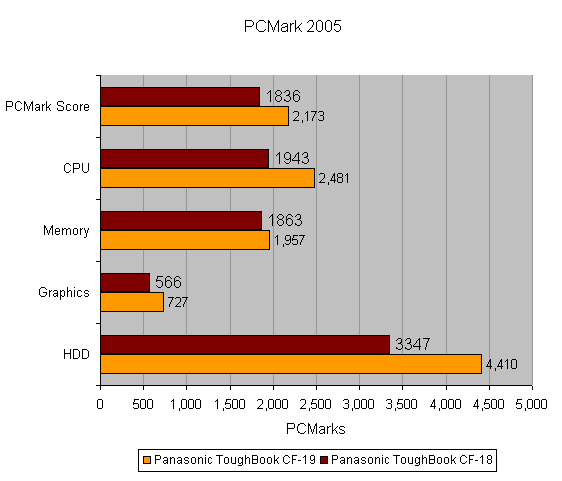
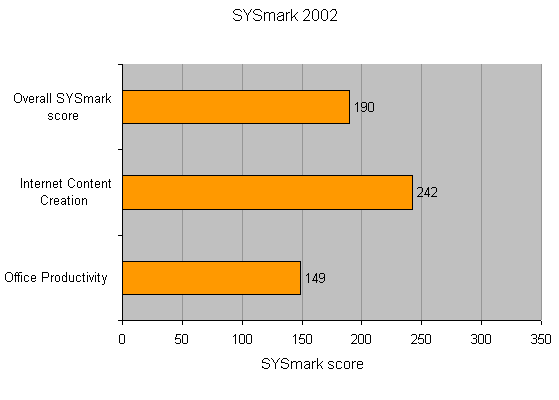
How we test laptops
Unlike other sites, we test every laptop we review thoroughly over an extended period of time. We use industry standard tests to compare features properly. We’ll always tell you what we find. We never, ever, accept money to review a product.
Trusted Score
Score in detail
-
Performance 8
-
Value 7
-
Features 8

